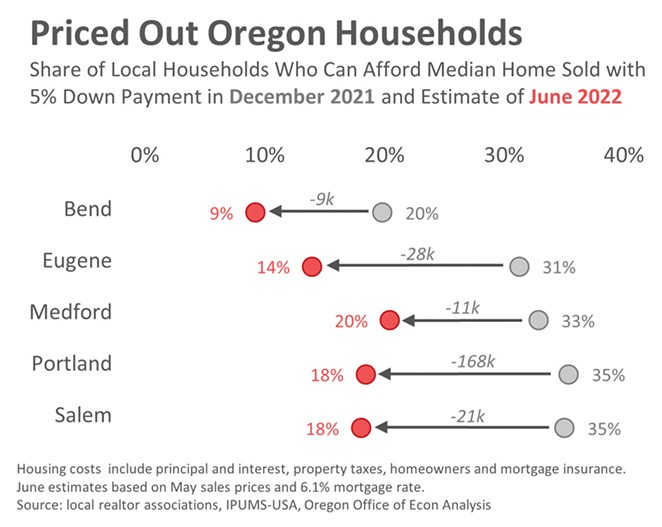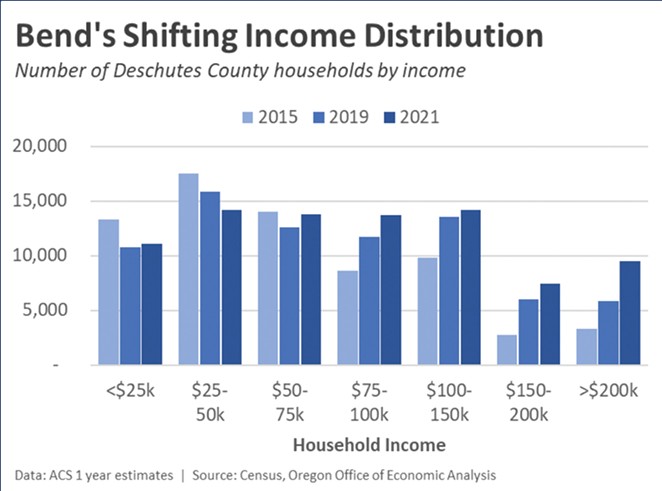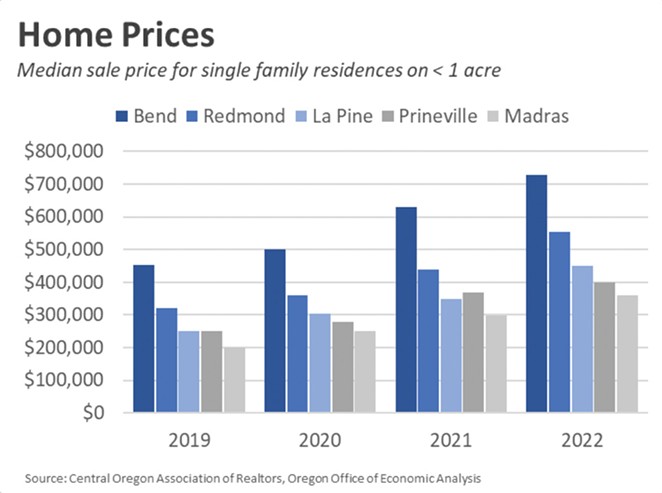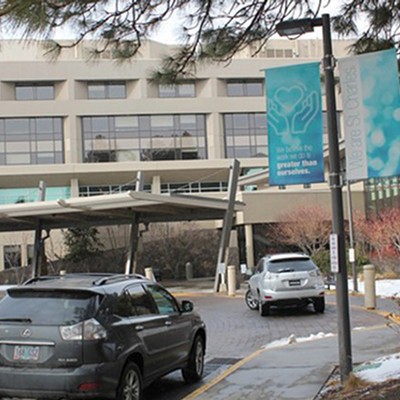You hear it all the time: Bend is constantly growing. Just 30 years ago Bend was a small logging town with a population just above 20,000. Last year, the U.S. Census Bureau announced Bend's population reached the low six figures. Running parallel to this narrative are stories of people having to leave the area, priced out as the cost of real estate and rentals soar.
The median price for a home in Bend reached a new high in July at $800,000. Three years prior, the median home cost $464,000, which was still about $100,000 higher than the national average. To afford a house in Bend today, with 28% of income going toward a mortgage and a 20% down payment, a household would need to earn over $170,000 a year. The median household income is just under $75,000. At that income, and after taxes, you'd earn just enough to rent a median 2-bedroom apartment in Bend, which is $2,050, according to Zumper, a rental-listing website.
The Oregon Department of Land Conservation and Development estimates that 47% of Bend's renters spend more than 30% of their income on housing, and one in four renters spend more than half of their paycheck. The high cost for housing raises a question of how someone establishes roots on the porous basalt surface in Bend. The impacts of housing-burdened Bendites could be delayed retirements, less leisure time and even homelessness.
"The landlord felt they weren't breaking even, having us be at $2,500 a month based on their mortgage, plus the utilities for the shared property. So it went up about $500 during the pandemic," said local renter Jessica Gamble, who's lived in both rentals as well as camping on public land in order to stay in Central Oregon. "I was camping and I was staying in hotels as much as I could. I chose to camp at campgrounds in this chapter for the safety of my family."
Where People Move
Portland State University's Population Research Center estimated that 16,000 people left Oregon in 2022, but all three Central Oregon counties deviated from the rest of the state. Between June 2021 and 2022, Crook County grew 2.5%, Jefferson County 1% and Deschutes County half-a-percent.
"Growth in Deschutes County in recent years is slower than it's been in recent decades. That relative pattern of slower growth, negative at the statewide level for one year, but slow down overall in the last handful of years, that is still true in Central Oregon," said Josh Lehner, a senior economist for the State of Oregon.
Lehner said Crook County is the one community in Central Oregon that's seeing faster growth than it has in the past. Part of that is scale. Crook County's 2.5% population growth translates to just 622 new residents. Deschutes County almost doubled that number in the same time period. But, fewer people have been moving to Bend over the past few decades. Between 1990 and 2000, Deschutes County grew by over 50%. It slowed to 36% between 2000 and 2010, and to 25% from 2010 to 2020.
"I think some of that largely has to do with the cascading migration effect, and we see this throughout the neighboring counties of 'Zoom towns' in the western United States or the Pacific Northwest where yes, Bend, Spokane, Missoula, Bozeman, these sort of places, are fast-growing, highly desirable places to live. There's no question about that, but it's actually the surrounding communities that grow even faster than them," Lehner said.
Lehner believes there are two primary reasons for the cascading migration effect. First, that people have been priced out of the more expensive economic hub and move to cheaper surrounding communities. Second is that some people may prefer to live in small towns.
The latest migration data in 2020 showed Deschutes County gets about a third of its in-migrants from in-state, a third from California and a third from all other states combined. Data about migration tends to lag, but there is an increasing number of high-earners in Bend. The number of households making over $150,000 has more than doubled since 2015. Nearly 10,000 households in Bend made over $200,000 in 2021 — in 2015, only around 3,000 households crossed that threshold. There's also an increase in people making just above the AMI, between $75,000 to $100,000, but the number of people making anything below $50,000 is trending downward. Bend's AMI is shifting higher as the city grows, but it's common for fast-growing areas to also see more people skipping town simultaneously.
"In the big picture of migration is places that have faster growing net-migration; they tend to see both higher levels of in-migration and out-migration. They see higher and higher turnover, higher churn, higher levels of migration, both in and out. All that tends to be the case, whether that's true or not in recent years in Central Oregon explicitly, I don't know off hand," Lehner said.
Growth corresponded with higher home prices in other Central Oregon communities, but they're still catching up to Bend. Redmond's median home cost $500,000 in July, about $150,000 more than it did three years ago. The median house in Sisters was $694,000 in July, a new peak. The cost of a home in Jefferson and Crook counties rose sharply over the past three years, but homes in those counties still sell for less than the median home in the whole United States.
Economy of a Zoom Town
There are indicators that fewer people are even trying to move to Central Oregon. A Bend Chamber of Commerce poll from October reported that 95% of local business owners say the high cost of housing limits their ability to hire qualified candidates, and 91% said their current workforce and company growth was negatively impacted by the high cost of housing.
"Businesses are having trouble hiring, and right in that middle-market, if you will. So, from about 80% to 120% of area median income," said Garrett Jaenicke, the director of marketing at the Bend Chamber of Commerce. "You can imagine that the plumbers, electricians, the landscapers, the folks that work in grocery stores, the folks that work in restaurants, nurses, fire department, policemen, all those folks in that middle market, are having trouble being able to find housing here. Businesses can't hire, so that impacts their level of service that they can provide."
Inability to recruit and retain a workforce is a central tenet in recent union negotiations at Bend's two largest employers. The Bend Education Association, which represents teachers at Bend-La Pine Schools, requested a 14% cost of living increase, along with workplace protections on safety, pupil-to-teacher ratios and more time to prepare lessons. Nurses at the St. Charles campus in Bend said the hospital system lost 549 nurses between 2018 and 2022. In June, the Oregon Nurses Association and St. Charles agreed to a massive pay raise — over 40% over the lifetime of the contract — after calling for a strike.
"One of the key factors nurses looked at was pay and benefits, because we hear from nurses who are looking at job offers across the state. We hear from nurses who said they wanted to live in Bend and to work at St. Charles, but they couldn't make the financial math work," said Kevin Mealy, communications manager of the Oregon Nurses Association.
Though the contract is still young, Mealy said its impact on recruitment seems positive. He said nurses around the state have spoken with him about the contract and how it can work as a standard for union negotiations. St. Charles spokesperson Alandra Johnson said St. Charles is actively hiring more people than it is losing. It also supports workforce housing initiatives and other affordable housing options to recruit employees.
The United States Chamber of Commerce said hiring rates have outpaced quit rates since July 2021. Even industries where employees tend to quit frequently, like leisure and hospitality, where the quit-rate fluctuated between 6.7% to 9%, are hiring more people than it loses. But Bend is still having issues. The Bend Chamber's workforce housing initiative attempts to solve for this by advocating for more dense housing and employer-funded housing projects. Most employers have been attempting to recruit through higher wages, but larger businesses can more effectively shoulder costs.
"I think overall, most businesses have been trying to accommodate the salary side still, to get their salaries up to be able to compete. In some cases, you're just not going to meet the gap between what inflation is driving and what the companies can afford," Jaenicke of the Chamber said. "I think that some companies have tried to get creative in offering more time off, flexible time off and kind of playing in that space. Some have amped up their contributions for health insurance."
But, the increase in high-income households could create a market for low-income work. Towns that house a lot of wealthy people also have a lot of jobs that Lehner, the state economist, terms "wealth work." These are primarily service jobs like house cleaners, lawn care specialists, dog walkers and personal trainers.
"Part of the reason why there's so much wealth is because it's a highly desirable place to live with scenic beauty. There's an airport, you can commute, you can work from home, and all these things kind of fit together to be an attractive place to live. That means you have bad housing affordability," Lehner said. "The flip side of terrible housing affordability is that means there's a lot of housing for the folks who are able to own property which then also attracts more higher income folks and high wealth folks that are able to live there and it just kind of feeds on itself."
Priced Out
Homelessness and affordable housing were the two biggest concerns of Bendites in the City's 2022 community survey. About 36% ranked homelessness as the biggest issues the City faced, followed by affordable housing at 25%. The two issues are inherently linked, though. People often believe mental illness, addiction and generous social programs cause homelessness. Those can all be factors why an individual becomes homeless. However, the most reliable metric associated with homelessness is the cost of housing. The U.S. Government Accountability Office found for every $100 increase in median rent, there's a 9% increase in the homelessness rate.
Jessica Gamble's rental property cost $2,500 when she started renting it. During the pandemic, though, her landlord changed the rent structure so she paid less in standalone rent, but took over utility payments. She said rental costs rose closer to $3,000, which she couldn't afford, especially since most of her rental payments were covered by vouchers. She and her family started staying at campgrounds and, when she could afford it, hotels. It wasn't her first time experiencing homelessness; she briefly lived off China Hat Road shortly after moving to Bend in 2018.
"What I found difficult when I was living out at China Hat was that there wasn't really a clear path out," Gable said. "A lot of the resources are either not up to date, or explained well, as far as how to find help. They basically hand you a large packet of paper, and it's like, 'good luck.' And so, you have to go through and call every single one."
Gable started the Home More Network to take some of the guesswork out of getting resources, whether it be a food bank, rental assistance or temporary shelter. Just a couple weeks ago she moved into stable housing after two years of camping. But her new place isn't in Bend — it's in one of the other, less-expensive communities in Central Oregon. Though she's happy with her new place, living outside of Bend does prove challenging for her and her family.
"The distance... all of the places that we need to go on a regular basis are in Bend. It is much more difficult, it's more costly as far as fuel goes and in time from adding on the commute. Now we try to condense all of our errands into one or two days a week, whereas before it would have been spread out throughout the week. There are fewer grocery stores and it's a much smaller town, so we're not able to get as much done," Gable said. "That part does make us wish that we still lived in Bend, for the convenience factor of it."




























